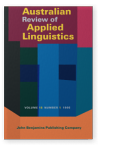Vol. 18:1 (1995) ► pp.129–146
Setting/interlocutor-related variation in oral performance of adult ESL learners
The performance of six adult intermediate second-language learners on an oral task was examined. The subjects, sharing a number of characteristics, e.g. the source language (Polish), performed the same task twice, with two different interlocutors, in two different settings (familiar vs. ‘real-life’). The aim of the study was to investigate the influence of the familiarity of the setting/ interlocutor factors on the subjects’ performance. To analyse the surface structure errors obtained from the two interviews, Selinker’s (1972) error taxonomy was employed, thus yielding five error categories: language transfer, overgeneralization, simplification, communication based and teaching induced errors. The findings revealed that the unfamiliar, ‘real-life’ setting elicited significantly higher proportion of language transfer errors than the same task performed in the familiar environment. It is argued that adult, intermediate second-language learners, in a new, ‘real-life’ social setting, when confronted with an unfamiliar native speaker of the target language, revert to their native language, fall back on their prior knowledge to facilitate the task demands.
